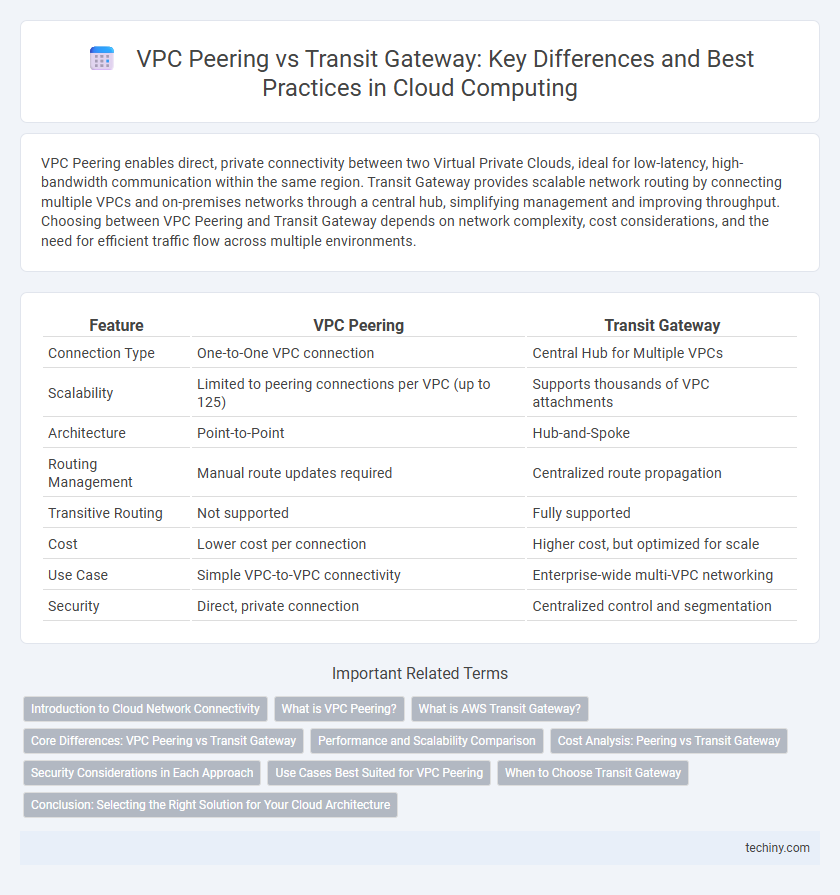VPC Peering enables direct, private connectivity between two Virtual Private Clouds, ideal for low-latency, high-bandwidth communication within the same region. Transit Gateway provides scalable network routing by connecting multiple VPCs and on-premises networks through a central hub, simplifying management and improving throughput. Choosing between VPC Peering and Transit Gateway depends on network complexity, cost considerations, and the need for efficient traffic flow across multiple environments.
Table of Comparison
| Feature | VPC Peering | Transit Gateway |
|---|---|---|
| Connection Type | One-to-One VPC connection | Central Hub for Multiple VPCs |
| Scalability | Limited to peering connections per VPC (up to 125) | Supports thousands of VPC attachments |
| Architecture | Point-to-Point | Hub-and-Spoke |
| Routing Management | Manual route updates required | Centralized route propagation |
| Transitive Routing | Not supported | Fully supported |
| Cost | Lower cost per connection | Higher cost, but optimized for scale |
| Use Case | Simple VPC-to-VPC connectivity | Enterprise-wide multi-VPC networking |
| Security | Direct, private connection | Centralized control and segmentation |
Introduction to Cloud Network Connectivity
VPC Peering and Transit Gateway are essential components for cloud network connectivity, enabling secure communication between multiple Virtual Private Clouds (VPCs). VPC Peering establishes a direct, one-to-one connection between two VPCs, ideal for simple network architectures with limited VPCs. Transit Gateway offers scalable, centralized interconnection for hundreds of VPCs and on-premises networks, optimizing traffic management and reducing complexity in large cloud environments.
What is VPC Peering?
VPC Peering is a networking connection between two Virtual Private Clouds (VPCs) that enables direct, private IP traffic routing without using the public internet. It supports low-latency, high-bandwidth communication while maintaining isolation and security between workloads hosted in different VPCs. VPC Peering is ideal for scenarios requiring simple, point-to-point connectivity without the complexity of managing a centralized router like a Transit Gateway.
What is AWS Transit Gateway?
AWS Transit Gateway is a highly scalable service that enables customers to connect multiple Virtual Private Clouds (VPCs) and on-premises networks through a single gateway, simplifying network architecture. It supports thousands of VPCs, allowing centralized connectivity and routing, reducing complexity compared to individual VPC peering connections. Transit Gateway enhances network performance and security by providing built-in routing controls and seamless integration with AWS Direct Connect and VPN services.
Core Differences: VPC Peering vs Transit Gateway
VPC Peering establishes a direct, private connection between two VPCs enabling low-latency, high-bandwidth communication without relying on an intermediary, making it ideal for simple point-to-point network architectures. Transit Gateway acts as a central hub that connects multiple VPCs and on-premises networks, supporting scalable, transitive routing with centralized management. Core differences lie in scalability and management complexity: VPC Peering requires managing individual peering connections for each VPC pair, while Transit Gateway simplifies the network by consolidating connections and routing policies.
Performance and Scalability Comparison
VPC Peering offers low-latency, high-throughput connectivity between specific Virtual Private Clouds, enabling efficient data transfer with minimal overhead but requires complex management as the number of peers increases. Transit Gateway centralizes network management by acting as a hub for connecting multiple VPCs and on-premises networks, significantly improving scalability and simplifying routing at scale, though it may introduce slightly higher latency compared to direct peering. For large-scale architectures with numerous VPCs, Transit Gateway delivers better performance consistency and ease of management, while VPC Peering is optimal for high-performance, low-latency links between fewer VPCs.
Cost Analysis: Peering vs Transit Gateway
VPC Peering offers a cost-effective solution for direct, one-to-one connections between VPCs, eliminating data transfer fees within the same region but scaling complexity and costs increase with multiple VPCs. Transit Gateway centralizes network management, enabling scalable hub-and-spoke architecture, but incurs hourly and data processing fees that can add substantial expenses for high-volume traffic. Evaluating monthly data transfer volume, number of VPCs, and network complexity is critical for determining whether VPC Peering or Transit Gateway delivers better cost efficiency in cloud environments.
Security Considerations in Each Approach
VPC Peering offers isolated, direct network connections between VPCs, minimizing exposure by avoiding transit through third-party devices; however, it requires strict route table management to prevent unintended access. Transit Gateway centralizes network traffic, enhancing scalable connectivity but introduces a single point where security controls must be meticulously configured to manage inter-VPC data flow and enforce segmentation policies. Both approaches necessitate robust IAM roles and security group configurations to mitigate risks of lateral movement and ensure compliance with organizational security standards.
Use Cases Best Suited for VPC Peering
VPC Peering is best suited for low-latency communication between a limited number of VPCs, such as connecting production and development environments within the same AWS region. It excels in scenarios requiring high-bandwidth, private connectivity without transitive routing, ideal for simple architectures with direct access needs. Organizations benefit from VPC Peering when maintaining isolated security boundaries while enabling secure resource sharing between specific VPCs.
When to Choose Transit Gateway
Transit Gateway is ideal for managing large-scale, complex network architectures requiring centralized connectivity across multiple Virtual Private Clouds (VPCs) and on-premises environments. It offers scalable bandwidth, simplifies network management by reducing peering connections, and supports advanced routing policies, making it suitable for enterprises with high traffic and diverse network topologies. Use Transit Gateway when you need a hub-and-spoke model to efficiently handle cross-region workloads and seamless integration with AWS Direct Connect or VPN.
Conclusion: Selecting the Right Solution for Your Cloud Architecture
Choosing between VPC Peering and Transit Gateway depends on the scale and complexity of your cloud architecture; VPC Peering offers direct, low-latency connections ideal for a limited number of VPCs, while Transit Gateway provides centralized, scalable interconnectivity suitable for large, multi-VPC environments. Cost-efficiency should align with traffic patterns and management overhead, as Transit Gateway simplifies routing at a higher price point, whereas VPC Peering reduces operational complexity in smaller setups. Evaluate network design requirements, security policies, and future growth to ensure the selected solution optimally supports performance and scalability goals in your cloud infrastructure.
VPC Peering vs Transit Gateway Infographic

 techiny.com
techiny.com